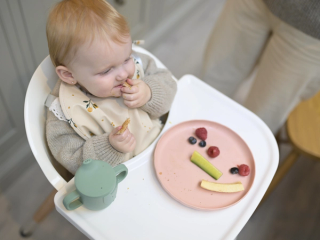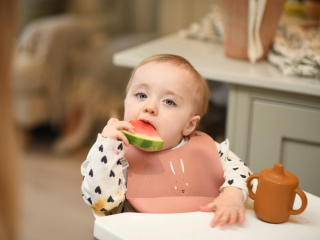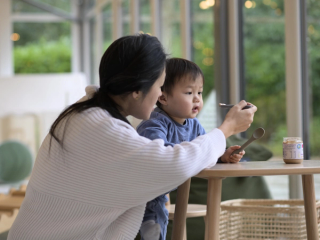
- Home
- Advice Hub
- Toddler
- Toddler Feeding
- Dealing With A Fussy Eating Toddler
Dealing with a fussy eating toddler
Learn how to cope with a fussy eating toddler. We provide expert tips on how to encourage your toddler to eat.
As a parent, it’s frustrating when your little foodie turns into a picky toddler, refusing meals, turning their nose up or giving an outright ‘NO!’. There’s no denying how hard this phase can be, but rest assured, with the right actions, your little one can thrive and you can keep your sanity intact.
Why Do Children Become Fussier?
Most babies are accepting of the foods we put in front of them. Then at some point between their first and second birthdays that picture can change quite dramatically, and you suddenly have a fussy eater toddler. What once felt easy or fun can become stand offs and battles at mealtimes.
So, what happens? Why do we go from parenting a happy accepting baby to a shouty avoidant toddler?
- Growth slows: this isn’t strictly a reason for fussy eating BUT it’s important to know that when babies reach a year old, growth slows. This leads to a decrease in appetite, so what can feel like fussy eating is often a child that simply doesn’t need as much food as they did before. They may eat their favourite part and leave the rest, leaving you feeling baffled, wondering why my toddler won’t eat
- Personality: Some toddlers are naturally more cautious, emotional, or strong-willed, which can make them more selective about the foods they eat. If your child has a strong personality, you may be more likely to start offering their favourites to avoid meltdowns.
- Anxiety: Whether it’s general anxiety or food-related anxiety, some toddlers may feel nervous about trying new foods, making mealtimes stressful.
- Sensory issues: Eating is a sensory experience, and different textures, colours, and smells can affect willingness to try new things. Sensory issues can play a big part in why your child avoids certain foods and why they seek out others. One of the reasons you may find them leaning towards beige crunchy foods and avoiding vegetables is consistency; a cracker will always be the same, but a banana will not!
- Normal development: toddlerhood is a time of growing independence and curiosity; human evolution has provided a reflex (known as food neophobia) to stop toddlers from eating foods they do not recognise. This reflex, which helped to keep early humans safe from poisonous ‘foods’, can make your child wary of new foods, even if they're perfectly safe. So, that broken biscuit that was refused is likely because of neophobia.
- Life changes: Big transitions like the arrival of a new baby, moving to a new house or starting nursery may all feel like positive life events they all have the potential to impact eating.
- Medical issues: previous reflux, food allergies, recurrent illness, neurodiversity and lots of others factors will affect how your child views foods and alters their eating habits. For example, with reflux; even if it is resolved your child will have memories stored of eating making them feel unwell which will stay with them for a long time.
How To Deal with Fussy Eaters
Dealing with a fussy eater doesn’t involve force or frustration. Instead, creating the right environment and maintaining a calm, consistent approach is key. Below is a handy table of dos and don’ts to help you encourage better eating habits without making mealtimes stressful.
As well as feeling frustrated that you’re wasting food and your precious time making it, you may also be worried about your little one getting the right nutrients and whether they are growing properly. Try not to worry, this is often just a phase that toddlers go through. Use our tips below to get yourself on the path to feeling more positive and reducing your overall stress levels.
Stick to a good routine. Aim for three meals a day and two snacks. Try not to offer food outside of these times as it’ll reduce their appetite at mealtimes.
Stay relaxed and keep mealtimes a calm social space. Focus on the interactions you have instead of the food.
Sit back and allow them to touch and play with the food while you eat something yourself. You can be a great role model for them to copy in their own time.
Keep offering the foods they have refused – the more often you expose a toddler to a food, the more likely they are to accept it and eat it.
Keep mealtimes regular and short – consistency is reassuring for children.
Take action to reduce your worries so it’s easier to step back. Offer a good multivitamin and have weight and height plotted every few months.
Change everything to fit in with their food refusals - the more you do this, the more likely the problem will continue.
Give up!
Force them to eat – the more pressure you put on them, the less likely they are to eat. Withdraw the food without any fuss and try it again another time.
Add foods to a ‘won’t eat’ list too soon – keep trying them.
Prolong mealtimes in the hope this will make them eat.
Offer more than around 400-500ml of milk.
Hide foods or trick your toddler. Creating mistrust, especially with their favourite foods is likely to backfire and you may end up with an even smaller range of accepted foods.
How to introduce new foods to a fussy eater?
The introduction of new foods is often less about the food itself and more about how you offer them. If you have a table – use it! Sit and eat together as often as you can.
Put all the food in the middle of the table and let everyone serve themselves. This helps your toddler to feel included in the meal and reduces the anxiety of having foods they don’t like on their plate contaminating their accepted foods. Think about it in this way, if you went to a restaurant and your food came out with a slug on the plate, would you want to eat your meal?
Finally - don’t pressure! The more you try to get your toddler to eat something the more they will resist. In the short term, try to worry less about nutrition and focus on getting the environment right and the food will follow after.
Top Tips for Fussy Eaters
One of the things I get asked a LOT is what are the best recipes for fussy eaters. I wish I could just write a picky eaters food list, but the reality is that it’s a very difficult question to answer because every child’s eating journey is slightly different and so are their preferences.
Some children love dry, crunchy beige foods. Whilst others want sweet or smooth foods.
Instead of trying to think of new recipes, try to ensure you are offering all of your child’s accepted foods across the week. Mix up when you offer foods and let go of food rules such as porridge is a breakfast food, and nuggets don’t go with rice. The more you can vary up your child’s diet within their safety zone the better.
Meet them in their space too to help them to feel included. For example, if your child leans towards bread create a family sharing board where everyone can make their own sandwiches with various fillings and maybe have some soup on the side for those who want it. Or if they like plain pasta, put a big bowl of plain pasta in the middle and a sauce with some cheese for the rest of the family.
I may sound like a broken record, but the more time you spend creating the right mealtime environment, getting into a good routine and allowing your child to find foods for themselves the better they will eat in the long run!
One day you’ll look back and wonder how they survived on so little. Until then – you’ve got this.
Final Thoughts
Fussy eating is a phase that many toddlers go through, but it doesn’t last forever. By following the right strategies, being patient, and creating a positive mealtime environment, you can help your child develop healthier eating habits over time. Remember to keep the bigger picture in mind – it’s not about each individual meal, but the overall balance of their diet across the week. And if you’re ever concerned, don’t hesitate to reach out to a healthcare professional.
You’ve got this – one mealtime at a time!








